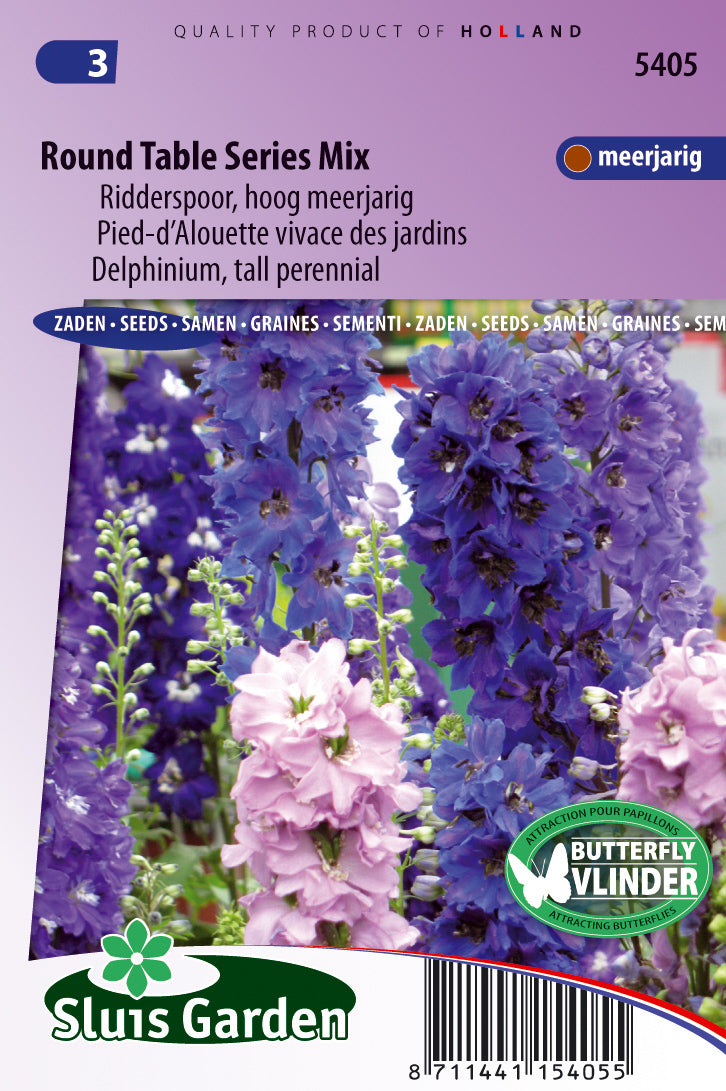1
/
of
1
Delphinium round table mix
Delphinium round table mix
Regular price
1.350 KWD
Regular price
Sale price
1.350 KWD
Unit price
/
per
Shipping calculated at checkout.
Couldn't load pickup availability
Delphiniums are well-loved perennial plants known for their tall spikes of vibrant flowers. Here's a guide on how to grow tall perennial Delphiniums:
**1. Sunlight:**
- Delphiniums prefer full sunlight. Plant them in a location that receives at least 6-8 hours of direct sunlight each day.
**2. Soil:**
- Choose well-draining, fertile soil with a slightly alkaline to neutral pH. Amend the soil with organic matter, such as compost, to improve fertility and drainage.
**3. Planting Time:**
- Plant Delphiniums in the spring or fall. Fall planting is often preferred in areas with mild winters to allow the plants to establish before the next growing season.
**4. Planting Depth:**
- Plant the crown of the Delphinium (the point where the roots meet the stems) at the soil level. Avoid planting too deep, as this can lead to crown rot.
**5. Spacing:**
- Space tall Delphiniums about 18 to 24 inches apart. Providing adequate spacing allows for good air circulation, which helps prevent diseases.
**6. Watering:**
- Keep the soil consistently moist, especially during dry periods. Water at the base of the plant to avoid wetting the foliage, which can reduce the risk of diseases.
**7. Mulching:**
- Apply a layer of organic mulch around the plants to help retain soil moisture and suppress weeds. Mulching also helps regulate soil temperature.
**8. Fertilization:**
- Fertilize Delphiniums with a balanced, all-purpose fertilizer in the spring when new growth begins. Follow the package instructions for application rates.
**9. Support:**
- Tall Delphiniums may need staking to support their flower spikes, preventing them from bending or breaking. Install stakes early in the season to provide support as the plants grow.
**10. Deadheading:**
- Deadhead spent flowers regularly to encourage continuous blooming and prevent the plant from putting energy into seed production. Remove the entire flower spike once it has finished blooming.
**11. Pruning:**
- After the first round of blooms, cut the plant back to encourage a second flush of flowers and maintain a more compact shape.
**12. Pests and Diseases:**
- Keep an eye out for pests like aphids and caterpillars. Treat any infestations promptly. Delphiniums can be susceptible to powdery mildew, so ensure good air circulation and avoid overhead watering.
**13. Division:**
- Divide mature clumps every 3-4 years in the early spring or fall to rejuvenate the plants and prevent overcrowding.
**14. Companion Planting:**
- Tall Delphiniums make excellent focal points in cottage gardens or mixed perennial borders. Consider planting them alongside other perennials with complementary colors and heights.
By following these guidelines, you can successfully grow tall perennial Delphiniums and enjoy their majestic spikes of flowers in your garden. Adjustments may be needed based on your local climate and soil conditions.
**1. Sunlight:**
- Delphiniums prefer full sunlight. Plant them in a location that receives at least 6-8 hours of direct sunlight each day.
**2. Soil:**
- Choose well-draining, fertile soil with a slightly alkaline to neutral pH. Amend the soil with organic matter, such as compost, to improve fertility and drainage.
**3. Planting Time:**
- Plant Delphiniums in the spring or fall. Fall planting is often preferred in areas with mild winters to allow the plants to establish before the next growing season.
**4. Planting Depth:**
- Plant the crown of the Delphinium (the point where the roots meet the stems) at the soil level. Avoid planting too deep, as this can lead to crown rot.
**5. Spacing:**
- Space tall Delphiniums about 18 to 24 inches apart. Providing adequate spacing allows for good air circulation, which helps prevent diseases.
**6. Watering:**
- Keep the soil consistently moist, especially during dry periods. Water at the base of the plant to avoid wetting the foliage, which can reduce the risk of diseases.
**7. Mulching:**
- Apply a layer of organic mulch around the plants to help retain soil moisture and suppress weeds. Mulching also helps regulate soil temperature.
**8. Fertilization:**
- Fertilize Delphiniums with a balanced, all-purpose fertilizer in the spring when new growth begins. Follow the package instructions for application rates.
**9. Support:**
- Tall Delphiniums may need staking to support their flower spikes, preventing them from bending or breaking. Install stakes early in the season to provide support as the plants grow.
**10. Deadheading:**
- Deadhead spent flowers regularly to encourage continuous blooming and prevent the plant from putting energy into seed production. Remove the entire flower spike once it has finished blooming.
**11. Pruning:**
- After the first round of blooms, cut the plant back to encourage a second flush of flowers and maintain a more compact shape.
**12. Pests and Diseases:**
- Keep an eye out for pests like aphids and caterpillars. Treat any infestations promptly. Delphiniums can be susceptible to powdery mildew, so ensure good air circulation and avoid overhead watering.
**13. Division:**
- Divide mature clumps every 3-4 years in the early spring or fall to rejuvenate the plants and prevent overcrowding.
**14. Companion Planting:**
- Tall Delphiniums make excellent focal points in cottage gardens or mixed perennial borders. Consider planting them alongside other perennials with complementary colors and heights.
By following these guidelines, you can successfully grow tall perennial Delphiniums and enjoy their majestic spikes of flowers in your garden. Adjustments may be needed based on your local climate and soil conditions.
Share

